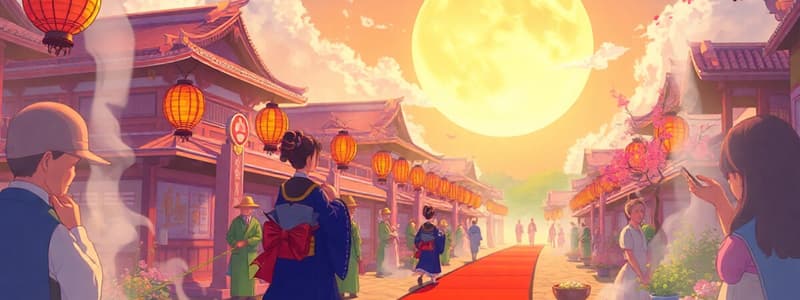Podcast
Questions and Answers
What is the primary focus of the Japanese tea ceremony, Chanoyu?
What is the primary focus of the Japanese tea ceremony, Chanoyu?
- Performing traditional dances
- Honoring ancestors
- Creating calligraphy art
- Preparing and serving matcha (correct)
Which traditional performing art is known for its elaborate makeup?
Which traditional performing art is known for its elaborate makeup?
- Kabuki (correct)
- Noh
- Bunraku
- Ikebana
What does Hanami celebrate in Japan?
What does Hanami celebrate in Japan?
- Cherry blossom viewing (correct)
- The autumn harvest
- New Year festivities
- Traditional clothing
What is the main ingredient in traditional sushi?
What is the main ingredient in traditional sushi?
Which script is NOT one of the three used in the Japanese language?
Which script is NOT one of the three used in the Japanese language?
Shintoism primarily focuses on what aspect?
Shintoism primarily focuses on what aspect?
What kind of garment is a Yukata?
What kind of garment is a Yukata?
What value is emphasized by the concept of 'Wa' in Japanese culture?
What value is emphasized by the concept of 'Wa' in Japanese culture?
Flashcards are hidden until you start studying
Study Notes
Overview of Japanese Culture
- Japan has a rich cultural heritage influenced by its history, geography, and society.
- Culture includes customs, traditions, art, language, and lifestyle.
Traditional Arts
- Calligraphy (Shodo): The art of beautiful writing using brush and ink.
- Tea Ceremony (Chanoyu): A ritualistic gathering with a focus on preparing and serving matcha.
- Ikebana: The art of flower arrangement, emphasizing harmony and balance.
- Kabuki: Traditional theater known for its stylized drama and elaborate makeup.
- Noh and Bunraku: Other forms of traditional performing arts; Noh is serious and slow, while Bunraku is puppet theater.
Festivals and Celebrations
- Hanami: Cherry blossom viewing in spring, celebrating nature and beauty.
- Obon: A Buddhist festival to honor ancestors, involving dance and lanterns.
- Matsuri: Various local festivals that showcase traditional dances, parades, and foods.
Cuisine
- Sushi: Vinegared rice combined with various ingredients, mostly raw fish.
- Ramen: Noodle soup with broth, toppings typically include meat, green onions, and seaweed.
- Tempura: Battered and deep-fried vegetables and seafood.
- Sake: Traditional rice wine, often served warm or cold.
Language
- Japanese language uses three scripts: Kanji (characters borrowed from Chinese), Hiragana, and Katakana.
- Honorifics and politeness levels are integral to communication.
Religion and Spirituality
- Shinto and Buddhism are the two predominant religions.
- Shinto: Focus on kami (spirits), rituals, and customs tied to nature.
- Buddhism: Introduced from Korea in the 6th century, emphasizes mindfulness, meditation, and enlightenment.
Architecture
- Traditional styles include:
- Shrines (Jinja): Simple wooden structures with thatched roofs.
- Temples (Tera): Often more ornate, featuring intricate carvings and gardens.
- Castles: Historic structures, such as Himeji Castle, reflecting feudal Japan.
Clothing
- Kimono: Traditional garment characterized by long sleeves and a wrap-around style.
- Yukata: A casual summer kimono made of cotton, worn mostly during festivals.
- Hakama: A pleated, skirt-like garment worn over the kimono for formal occasions.
Values and Etiquette
- Respect: Highly valued; bowing is a traditional greeting and sign of respect.
- Harmony (Wa): Emphasis on group consensus and social harmony.
- Obligation (Giri): A sense of duty and social obligation to others.
Modern Influence
- Japan is a global leader in technology, fashion, and pop culture (anime, manga, J-pop).
- Traditional customs co-exist with modern lifestyles, creating a unique blend of old and new.
Japanese Culture Overview
- Rich Cultural Heritage: Influenced by history, geography, and society.
- Key Components: Customs, traditions, art, language, and lifestyle.
Traditional Arts
- Calligraphy (Shodo): Art of beautiful writing with brush and ink.
- Tea Ceremony (Chanoyu): Ritualistic gathering focused on preparing and serving matcha.
- Ikebana: Flower arrangement emphasizing harmony and balance.
- Kabuki: Traditional theater with stylized drama and elaborate makeup.
- Noh and Bunraku: Other performing arts; Noh is serious and slow, while Bunraku is puppet theater.
Festivals and Celebrations
- Hanami: Cherry blossom viewing in spring, celebrating nature and beauty.
- Obon: Buddhist festival honoring ancestors, involving dance and lanterns.
- Matsuri: Local festivals showcasing traditional dances, parades, and foods.
Cuisine
- Sushi: Vinegared rice with various ingredients, often raw fish.
- Ramen: Noodle soup with broth, toppings include meat, green onions, and seaweed.
- Tempura: Battered and deep-fried vegetables and seafood.
- Sake: Traditional rice wine, served warm or cold.
Language
- Three Scripts: Kanji (characters borrowed from Chinese), Hiragana, and Katakana.
- Communication: Honorifics and politeness levels are crucial.
Religion and Spirituality
- Predominant Religions: Shinto and Buddhism.
- Shinto: Focus on kami (spirits), rituals, and nature-related customs.
- Buddhism: Introduced from Korea in the 6th century, emphasizing mindfulness, meditation, and enlightenment.
Architecture
- Traditional Styles:
- Shrines (Jinja): Simple wooden structures with thatched roofs.
- Temples (Tera): Ornate temples with intricate carvings and gardens.
- Castles: Historic structures like Himeji Castle, reflecting feudal Japan.
Clothing
- Kimono: Traditional garment with long sleeves and a wrap-around style.
- Yukata: Casual summer kimono made of cotton, worn during festivals.
- Hakama: Pleated, skirt-like garment worn over the kimono for formal occasions.
Values and Etiquette
- Respect: Highly valued; bowing is a greeting and sign of respect.
- Harmony (Wa): Emphasis on group consensus and social harmony.
- Obligation (Giri): Sense of duty and social obligation to others.
Modern Influence
- Global Leader: Japan is a leader in technology, fashion, and pop culture (anime, manga, J-pop).
- Unique Blend: Traditional customs co-exist with modern lifestyles, creating a unique blend of old and new.
Studying That Suits You
Use AI to generate personalized quizzes and flashcards to suit your learning preferences.



